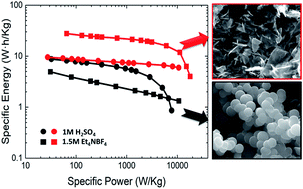Flat-shaped carbon–graphene microcomposites as electrodes for high energy supercapacitors†
Abstract
Herein, we report a simple approach for the preparation of phosphate-functionalized carbonaceous graphene-based composites. The homogeneous deposition of a thin layer of phenolic resin on the surface of graphene oxide (GO) sheets was achieved using phosphoric acid as the polymerization catalyst and functionalization agent. Subsequent pyrolysis of the composite yielded homogeneous lamellar-shaped microstructured porous carbon–graphene composites combining enhanced molecular diffusion and high electron transfer. In order to elucidate the effect of GO and porosity on the supercapacitor performance, a graphene free sample and a KOH-activated composite were also prepared and tested in a two-electrode configuration using aqueous and organic electrolytes. It was found that the presence of GO and the KOH activation lead to an increase in the specific surface area combined with a progressive widening of the pores. As a result, the KOH-activated composite reached specific capacitances of 211 and 105 F g−1 when using 1 M H2SO4 and 1.5 M Et4NBF4 electrolytes, respectively. It was also found that phosphorus-functionalization of electrodes leads to an operating voltage of 1.3 V in the aqueous electrolyte, resulting in a considerable increase of the energy density of the cell. Finally, both non-activated and activated graphene-based composites provide excellent capacitance retention, energy and power densities and cycling stability.



 Please wait while we load your content...
Please wait while we load your content...